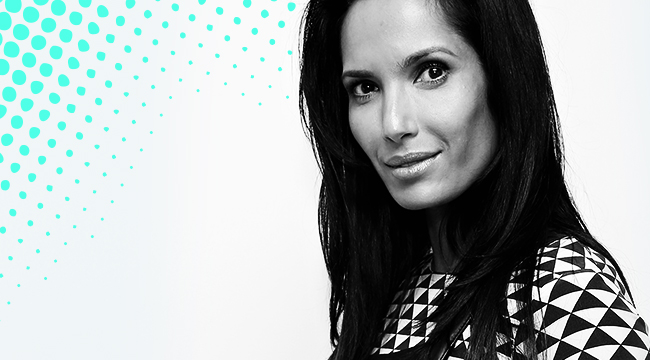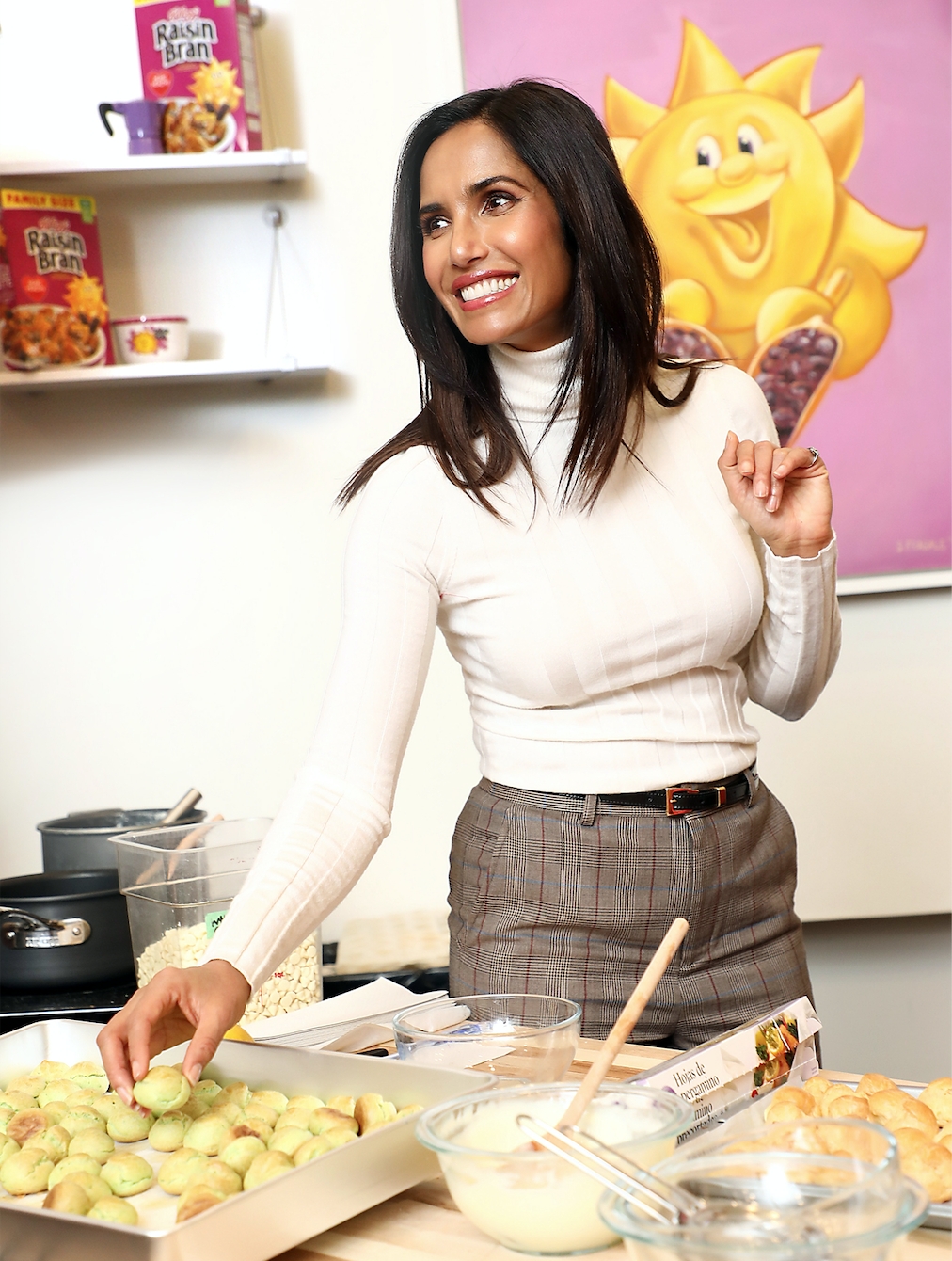
Padma Lakshmi is the sort of famous, wealthy, beautiful person you still fervently root for. There’s something about her that just seems real. From recent revelations about her painful past, to biting commentary about the food she’s served on Top Chef, to her solution-oriented response to Louis C.K.’s fumbled comeback — she’s the mega-star you’d invite to your personal last supper. Better still, upon arriving she might just offer a few choice words about the plating.
Last week, with Top Chef: Kentucky finding its groove, Padma hung out at the Kelloggs Cafe in New York City, judging a nation-wide holiday recipe contest. She also took time to slip a few jabs at the competitors of the Uproxx Cooking Battle — skewering our crustless-pies, boring caramels, and overzealous use of cedar. Once the judging was done, we had time to pepper the author/actress/host/model/food aficionado with a few more questions.
As is her practice, she was honest and funny, while also offering genuine insight about the future of inclusivity in the food scene.
You have a new partnership with Kellogg’s — was that a natural fit for you?
You know, I don’t live very far from their New York café and, frankly, I was always really curious about what went on up here. It’s on the second floor, so you can’t really peer in the window and see anything. And one of my favorite things to do in the kitchen is to repurpose ingredients into other recipes — which is what this contest I’m judging is about.
That idea of remixing recipes has always been important, but it seems to be something that people are really talking about right now.
If you look at my cookbook that came out several years ago, called Tangy, Tart, Hot and Sweet, you’ll see a recipe for a tie-dyed crumble, which is made of pineapple and pomegranate, which is very much in season right now. And crumbles are great at this time of year because they’re very forgiving, they can be reheated the next day, they’re easy to make. And in that crust, I’m using frosted flakes. You could use frosted flakes or you could use just cornflakes with a little bit of extra added sugar if that’s what you have. And it makes for a really mottled, beautiful crust.
If you look at my fried chicken recipe in the same book, you’ll see Rice Krispies. There are lots of ways to use cereal in ways that you wouldn’t normally think of. It’s great for giving texture.

Do you think that our modern food moment — where everyone feels like they have some degree of knowledge and a working understanding of food and culinary technique — actually helps that sort of fusion that you’re talking about, where someone goes, “Oh, I need a textural element, I could use cereal!”?
I hope so. I think it’s been a trend to use childhood staples or nostalgic ingredients that all Americans have seen growing up, in different ways. David Chang and his pastry chef Christina Tosi add cornflakes into their compost cookie. They also actually bottle and sell cereal milk and make cereal milk ice cream. And I’ve seen that sort of idea wind up on menus at very fine dining restaurants across the country.
I think it’s wonderful whenever you can stagger into the kitchen and use what you’ve got. You know, I’m always wary of a recipe that has 45 ingredients — 20 of which you’ll only use half a teaspoon of and then they’ll sit rotting in your pantry for the next two years. It’s nice whenever you can repurpose things. I use saltines crackers when I make casseroles sometimes. Like I used it in a zucchini pudding recipe. A savory zucchini pudding.
I think the whole idea of those sorts of comforting foods that represent our nostalgia for childhood is particularly interesting in this exact political moment, right? Because we all have cultures we want to represent. How does food interact with the tough times that we’re going through politically?
The thing that comes rushing to mind is my work advocating for immigration rights with the ACLU. I’m their ambassador for women’s rights, but I’ve been really busy, obviously, with the immigration issue. I, myself, am an immigrant and I was also raised by a single mom who worked full time. If you go into the back of any restaurant and look in their kitchen, what you will find is nothing but immigrants. That’s because it’s a very low point of entry and they cost less per hour because they need the money and they need the job and they don’t have resumes yet, because they just got here. So immigrants and people of color — whether they’re African or Asian or South American — they are the ones who are making, picking, manufacturing, packaging and cooking most of the food that Americans eat.
I think we’ve gotten scared sometimes because people say, “Oh, they’re taking away our jobs,” and things like that. But I really believe that there’s room for everyone. All of us. That if we look at how we eat and we’re fair about it, we don’t have to take a job from anyone who’s been born and raised here for generations. There’s enough to go around. I think that’s the way that my advocacy has taken shape, because I’ve been in a lot of restaurants. I know that the American food scene is what it is because of the contributions of generations upon generations of immigrants. Be they German or Guatemalan.
https://www.instagram.com/p/BqXvYvFhyYA/
Is the changing food scene — and people talking and buzzing about food — something that seems really thrilling to you?
Yeah, I mean that’s the thing that gives me hope. Because I think the more that somebody is interested in the food they eat, the more likely they are to eat better and healthier. That’s why I really encourage getting your children involved in the preparation of the family meal as soon as possible. Even if it’s just breaking the ends off beans or peeling potatoes or washing the lettuce. Whatever they can do. Because if a child takes ownership for a dish, they can take pride in it and they’ll be more likely to eat it, taste it, and experiment with it. You give that child a gift of good eating for the rest of their lives, long after you’re gone and, hopefully, that’ll get passed down to their children and grandchildren.
I think that Americans are much more interested in the food they eat because they’re becoming more health conscious. They want organic, they want dishes that feel authentic. They want to know that they’re doing right by their families. So all of that is good and I’m very proud of the contribution that Top Chef has made to that discussion. I think when I was 15 years old, I certainly didn’t know what an amuse-bouche was, but I get stopped on the corner when I’m hailing a cab all the time by tweens and teens telling me how much they love Top Chef. You’d be surprised how many bar mitzvahs I’ve been invited to.
Last week we had a piece about you guys needing to get a Native American chef on the show, written by a Native American writer. As his editor, I’ve never gotten so much e-mail in my life. It came from people up in the frozen tundras of Canada and down to the furthest southern tip of Florida saying that they are Native Americans chefs and want that platform for their creativity too.
I’d love that. I’d love to have a Native American chef on the show. Because really that’s the only truly traditional American food. So it’s really important to represent that.
You know, we can only pick chefs from those chefs who come to us. And we do practice affirmative action, in a way, because when we cast, we cast an equal amount of women as men and if you look at the professional food world, that is not the case at all. Our struggle is to be fair and representative, but also take people who are at a level to compete seriously. It’s not fair and it doesn’t do anyone any good, least of all that chef, if we know that he or she will never be able to compete with the level that the other chefs are cooking at.
You know, in a way, it’s sort of like by the time you get to Top Chef, it’s like Harvard. We need to encourage women and people of color and Native Americans to join the food industry at the beginning stages of the profession, where we also make the hours easier for women, so that they don’t have to choose between motherhood and being a chef. At the bottom line of cooking, it’s all manual labor. You have to be on your feet, the hours are terrible, you’re never going to be home for lunch or dinner with your family. So those are considerations that everyone has to take.
There are great strides being made to open the industry up to everyone. Like Danny Meyer runs an ESL program for his dishwashers and busboys here in New York so that they can learn English better and advance because he’d rather promote from within. They pay employees for taking that class.
Improvements are happening. Change comes in little drips and drabs and we take steps back as well. But hopefully, over the long arc of time, we are moving in the right direction.
https://www.instagram.com/p/BpUmH42BLYF/
Okay. I asked every single writer on our team what questions they wanted to ask and everyone wanted to know if occasionally a bite came through on the show that was just flat out inedible?
Like a really crappy bite of food?
The worst.
The worst? I’ll tell you. I’m happy to call him out. Michael Midgley, on my first California season, made this weird canape with some kind of chocolate bar rolled in coconut with a Cheeto stuck in the middle of it. It was just dumb and not very good.
I can call out two people. Ilan Hall, second season, last episode. Instead of Barbara, Eric Ripert as the guest judge. In a Quick Fire, he made this beautiful chocolate ganache with a morsel of liver embedded into the center of it and talk about a terrible idea… It was really entertaining trying to watch him explain his way out of it to Mr. Ripert. I just had to sit back and let it roll.
https://www.instagram.com/p/Bozll7uF-8z/






